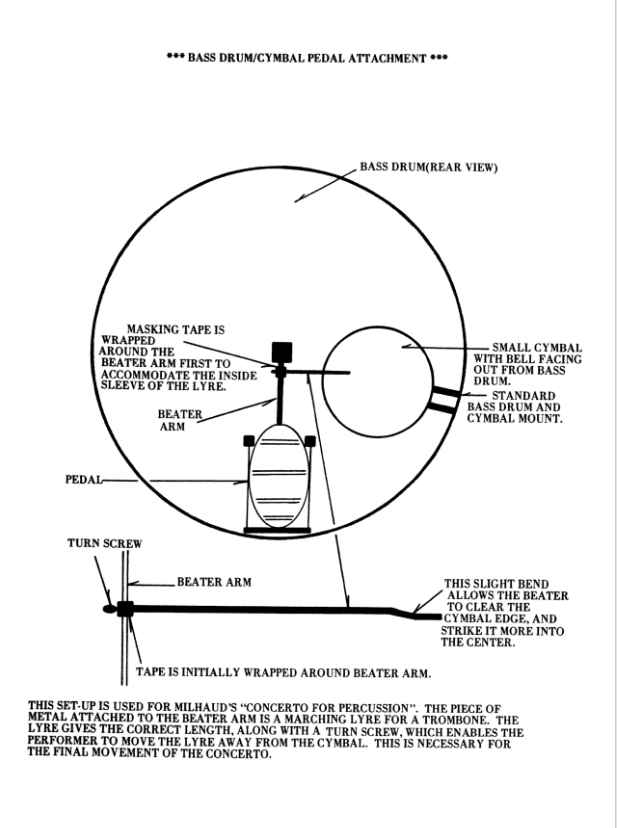Concerto for Percussion and Small Orchestra
General Info
Year: 1929
Duration: c. 7:00
Difficulty: (see Ratings for explanation)
Publisher: Universal Edition
Cost: Perc. Score and Piano- $29.95 | Score Only - $0.00
Movements
I. Vif, Rude et dramatique
II Modéré
Instrumentation
Player I: timpani(4), tom-toms(3), suspended cymbal, cymbals α2, bass drum with cymbal attachment on foot pedal, castanets, ratchet, slapstick, triangle, cow bell, tambourine, wood block
Program Notes
Concerto for Percussion and Small Orchestra is one of the first concertos’ written for a percussion soloist, and is one of the most performed pieces in the repertory. Being written in the 1920’s, this piece was written at the peak of jazz music, however, Milhaud was intent on not including jazz ideologies in his music, he countered the jazz style by composing this piece in a polytonal form. Looking at the opening motif, we can hear that it is played in C Major, A Minor, A Major, and C Sharp Minor simultaneously. The percussion ideas used in this piece are not so much composed with a soloistic approach, but rather the entire percussion section being played by one person. The piece was written in Paris for small orchestra, and is often played in conjunction with La Creation du Monde. - Trevor Landreth, 2015
Milhaud was a French composer and teacher and was a member of Les Six. His compositions are influenced by jazz and make use of polytonality, which is music in more than one key at the same time. Milhaud studied composition, harmony, and counterpoint at the Paris Conservatory. In 1922 Milhaud heard authentic jazz for the first time on a trip to the United States, which left a great impact on him. In 1939 Milhaud left France and moved to the United States, unable to return home until after the Liberation due to his Jewish background. Milhaud taught at Mills College in Oakland California, and some of his former students include Dave Brubeck, Philip Glass, and Steve Reich. From 1947 to 1971 Milhaud taught alternating years at Mills College and the Paris Conservatory.
Concerto Pour Batterie et Petit Orchestre (Concerto for Percussion and Small Orchestra), completed in 1930, is a significant benchmark in the percussive world. This concerto is the first of its kind, utilizing a multi-percussion style setup including over twenty wood, metal, and membrane instruments performed by one player. James Blades, author of Percussion Instruments and their History claims that “this work necessitates no small amount of athleticism.” While composing this piece, Milhaud’s intentions were to avoid a reference to the newly popular jazz genre. In tonality he has succeeded, but Milhaud calls for a kick drum with an attached cymbal mechanism, which was often used during the time on drum sets.
There are two distinct parts making up the form of this concerto: “rude et dramatique”, and modere. Milhaud composed the first “harsh and dramatic” movement to include bitonal harmonies found in the accompaniment (orchestra or piano). In the “modere” section, the piece explores a more lyrical and expressive path, intensifying to a final statement showcasing each instrument used throughout the concerto. Elizabeth Kosko, 2010
Errata
Awards
Commercial Discography
Online Recordings
Recent Performances
Trevor Landreth - Emporia State University, Spring 2015.
Elizabeth Kosko - Emporia State University, Spring 2010.
To submit a performance please join the TEK Percussion Database
Works for Percussion by this Composer
Concerto for Marimba, Vibraphone and Orchestra - Marimba, Vibraphone; Orchestra
Concerto for Percussion and Band - Multiple Percussion; Band
Concerto for Percussion and Small Orchestra - Multiple Percussion; Orchestra
Elegy for Pierre - Multiple Percussion; Viola
Additional Resources
PERCUSSION MASTERCLASS ON WORKS BY CARTER MILHAUD AND STRAVINSKY (Meredith Music Master Class)
(Meredith Music Resource). This latest work in the Meredith Music master class series presents a comprehensive, interpretive analysis and performance guide of three legendary compositions for timpani and percussion. Together, Morris Lang, Charles Dowd, and Anthony J. Cirone have put a lifetime of performance and study experience into an extensive volume featuring Eight Pieces for Four Timpani by Elliott Carter, Concertino for Percussion and Small Orchestra by Darius Milhaud and l'Histoire du Soldat by Igor Stravinsky. This in-depth, one-of-a-kind publication includes: corrections of wrong notes, rhythms, phrasings, and dynamics; far-reaching suggestions on interpretation; revised notation when original music was difficult to read; suggested muffling to enhance interpretation; additional articulations when appropriate; suggested sticking to increase musical phrasing; historical references.
From Percussion Repair and Maintenance: A Performer's Technical Manual - Mark P. Bonfoey, Anthony J. Cirone[1]
References
- ↑ Bonfoey, Mark. Percussion Repair and Maintenance: A Performer's Technical Manual. Alfred Music, 1986.
